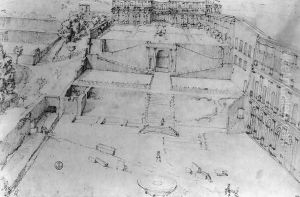Giovanni Antonio Dosio Paintings
Giovanni Antonio Dosio was an Italian architect and sculptor, born in 1533 in San Gimignano, Tuscany. He is best known for his works in the late Renaissance period. Dosio initially trained as a goldsmith, but his interests and talents soon expanded to encompass architecture and sculpture. In his early years, he was influenced by the work of Michelangelo and the architectural principles of Vitruvius.
In 1550, Dosio traveled to Rome, which was then a vibrant center for the arts, nurturing his development as an artist. In Rome, he studied ancient Roman architecture and ruins, which greatly influenced his later work. He became a part of the intellectual and artistic circles of the city, associating with prominent figures of the time. Dosio's works are characterized by their classical inspiration, harmonious proportions, and the integration of sculptural elements within architectural designs.
Dosio's career spanned various Italian cities, and he worked on several significant projects. In Naples, he was involved in the renovation of the Castel Nuovo and the design of the Palazzo Como. Back in Tuscany, he contributed to the design of the Santo Spirito in Florence and the renovation of the San Lorenzo church. His architectural style often reflected a Mannerist aesthetic, exhibiting an elegant complexity and a penchant for elongated forms.
Despite his numerous works, Dosio did not achieve the same level of fame as some of his contemporaries. Nonetheless, he left an indelible mark on the architectural and artistic landscape of Italy. His drawings and plans provide valuable insight into the architectural practices of the Renaissance. Giovanni Antonio Dosio passed away in 1611, leaving behind a legacy that continues to be studied and appreciated by art historians and architects.
